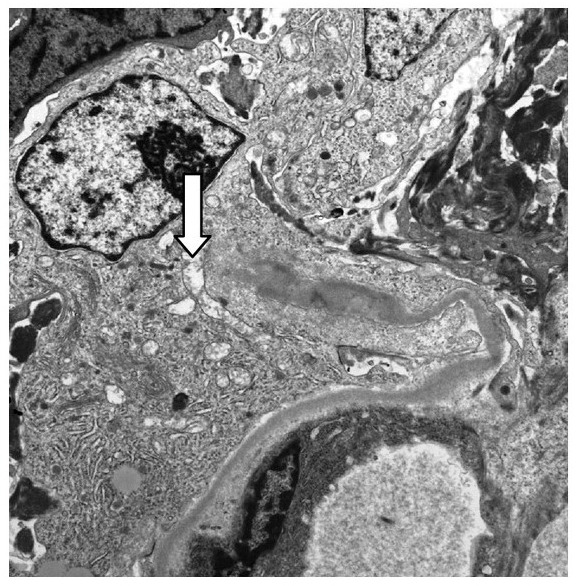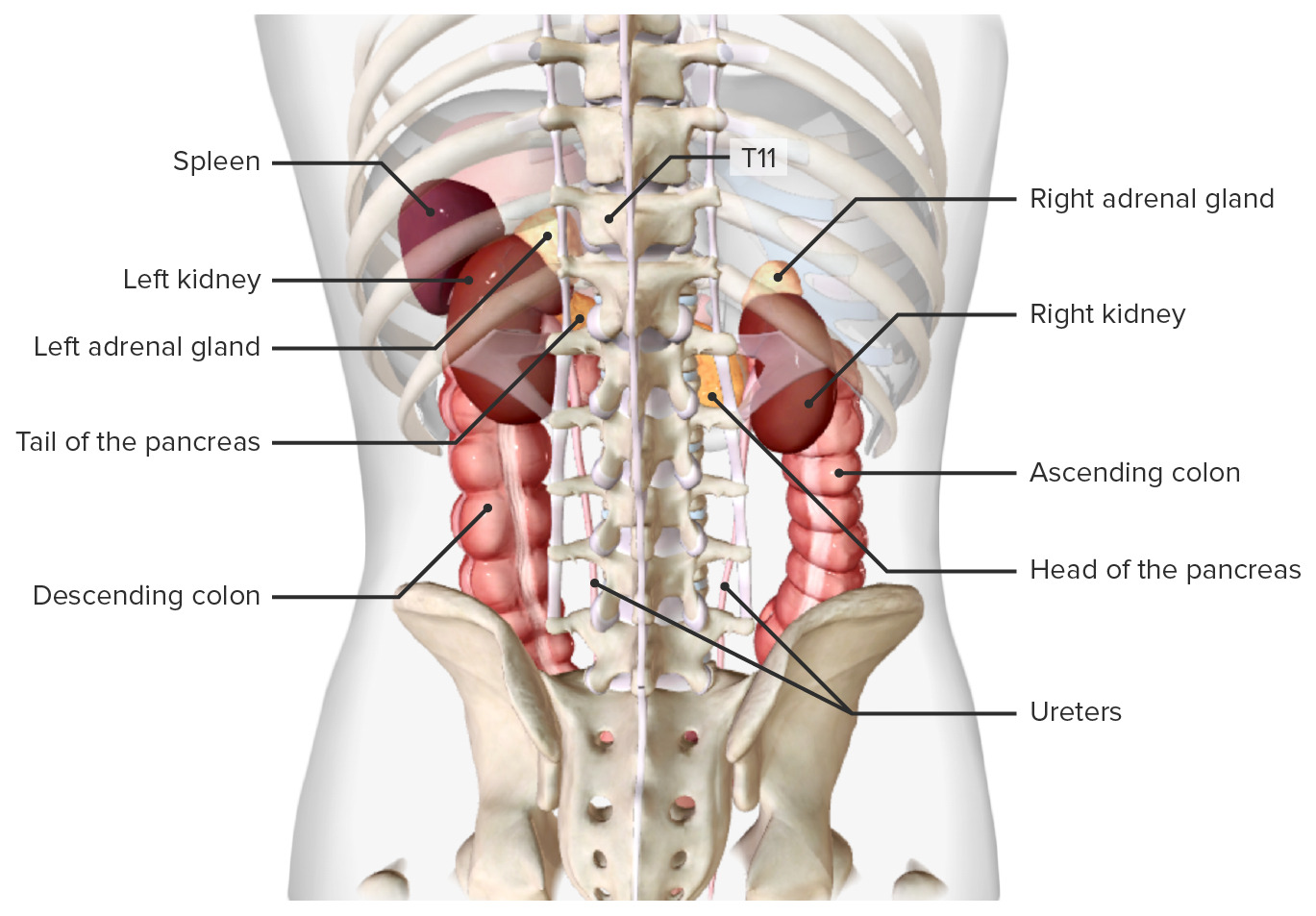Playlist
Show Playlist
Hide Playlist
Classification of Membranoproliferative Glomerulonephritis (MPGN)
-
Slides MembranoproliferativeGlomerulonephritis RenalPathology.pdf
-
Reference List Pathology.pdf
-
Download Lecture Overview
00:00 Current day classification. 00:02 First, immunofluorescence microscopy. You know what that means. 00:07 Immunofluorescence is literally looking for immunoglobulins. 00:11 Let’s first take a look at the arm on your left, shaded light gray, where we find immunofluorescence shows immunoglobulin Ig plus C3 deposits in the capillary wall plus the mesangium. 00:25 Now, you’re anatomically or you’re thinking and seeing all this at this juncture. 00:29 Next, this is immune-complex mediated MPGN. 00:33 Membranoproliferative glomerulonephritis, stop there. 00:36 Immune-complex mediated. What does that mean to you? It will be a type III type of hypersensitivy. 00:42 This would be the most common type MPGN etiology that we’ll take a look at in general. 00:49 Next, well, we'll take a look at to determine the source of the circulating immunoglobulin or immune complexes. 00:56 By that I mean, that immune complex that's being deposit now as a whole, as I said, this will be the most common etiology. 01:02 And you’ll see the differentials upcoming. 01:05 To determine the source, maybe it was an infection. 01:08 The big infection that you wanna keep in mind here is Hepatitis C. 01:14 What others? Well, the other ones, we have autoimmune diseases including rheumatologic diseases and this... 01:20 that will include things like Sjogren rheumatoid arthritis, Scleroderma, SLE, and so forth. 01:27 What else may have immune-complex deposition? Monoclonal gammopathies or dysproteinemias. 01:35 Big example here will be monoclonal gammopathy of undetermined significance and multi-myeloma. 01:42 Or something like Waldenstrom macroglobulinemia. 01:45 This is our first category of MPGN, it’s immune-complex mediated. 01:50 Next, what if the immunofluorescence shows dominant C3 staining with little or no C1q? That then brings us to our branch on the right. 02:03 This will be complement-mediated MPGN. 02:07 Complement-mediated. Stop there. 02:09 Take a look at the two major classifications. 02:12 We have immune-complex and we have complement-mediated. 02:16 If it is complement-mediated then your next step of management or at least your next step at diagnosis would be in fact your electron microscopy. 02:23 Now, what's this electron microscopy? If you find that your entire basement membrane is black and thick, thick and black, a rare, but you still need to know it big time, then it’s DDD. 02:37 That triple D stands for dense deposit disease. 02:42 Once again, dense deposit disease. 02:45 Where? On the basement membrane, it's black and thick. 02:48 This is your electron microscopy. 02:51 Whereas, well, you can have issues with what's known as C3 glomerulonephritis, as well. 02:57 A separate issue. We’re not gonna spend a lot of time there. 03:00 But we will spend time with type II MPGN. 03:04 Listen, type II MPGN, is only associated with dense deposit disease. 03:11 Is that clear? Let me ask you something else. 03:13 Well, let me finish this up then I’ll ask you, of the two, immune-complex or complement-mediated, which one of these would be more common in terms of occurrence? And you’ll see what I'm getting to. 03:26 Dysregulation of alternative complement pathway, the alternative complement pathway. 03:33 So what do you end up having? Is the fact that you have antibodies to complement regulators. 03:39 These are the important points that you wanna take away from this flow chart to give yourself a bird’s eye view how to approach your patient with MPGN and then as we go further through here we’re gonna plug-in the details. 03:49 Let us now continue.
About the Lecture
The lecture Classification of Membranoproliferative Glomerulonephritis (MPGN) by Carlo Raj, MD is from the course Glomerulonephritis.
Included Quiz Questions
What is the rationale behind the classification system of type 1 and type 2 membranoproliferative glomerulonephritis?
- Type 1 is immune complex mediated, while type 2 is complement mediated.
- Type 1 is infection mediated and type 2 is autoimmune mediated.
- Type 1 involves autoantibodies and type 2 is related to monoclonal gammopathy.
- Type 1 is monoclonal gammopathy related and type 2 is complement mediated.
- Type 1 is malignancy related and type 2 is autoimmune mediated.
What is rheumatoid factor?
- An autoantibody directed against the Fc portion of the IgG antibody
- An antibody that precipitates on cooling of the blood
- An autoantibody directed against phospholipids
- An autoantibody directed against neutrophil cytoplasmic antibody
- An autoantibody directed against components of the glomerular basement membrane
Which of the following pathologies is NOT associated with Type I MPGN?
- HIV infection
- Rheumatoid arthritis
- Monoclonal gammopathy of undetermined significance
- Hepatitis C infection
- Scleroderma
What pattern would you expect on immunofluorescence microscopy with type I MPGN?
- Subendothelial and mesangial immune complex and Ig + C3 deposits.
- IgA, IgG, and C3 deposits in the mesangium.
- No pattern on immunofluorescence.
- The linear pattern of immune complex deposition.
- Subendothelial immune complex deposits.
Which of the following conditions is associated with type 1 MPGN?
- Hepatitis C infection
- HIV infection
- Colon cancer
- Streptococcal infection
- Granulomatosis with polyangiitis
Which of the following immunofluorescence microscopic findings is characteristic of type 1 MPGN?
- Ig + C3 deposition in the capillary wall and mesangium
- Dominant C3 staining with little or no C1q
- Normal Immunofluorescence microscopic findings
- Nonspecific focal deposits of IgM, C3, and C1
- Ig + C1 deposition in the capillary wall and mesangium
Which of the following is synonymous with type 2 MPGN?
- Dense deposit disease
- Buerger disease
- Berger disease
- Crescentic glomerulonephritis
- Lipoid nephrosis
Customer reviews
5,0 of 5 stars
| 5 Stars |
|
5 |
| 4 Stars |
|
0 |
| 3 Stars |
|
0 |
| 2 Stars |
|
0 |
| 1 Star |
|
0 |






